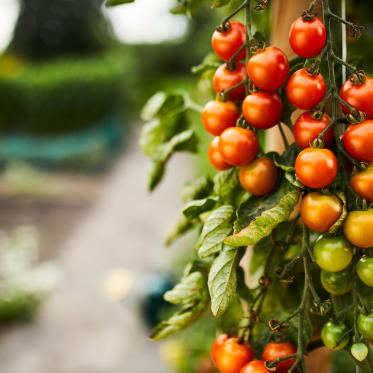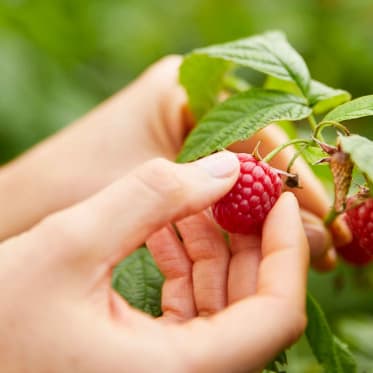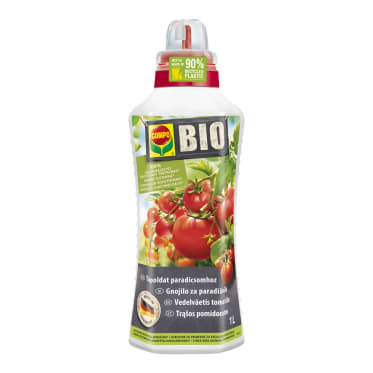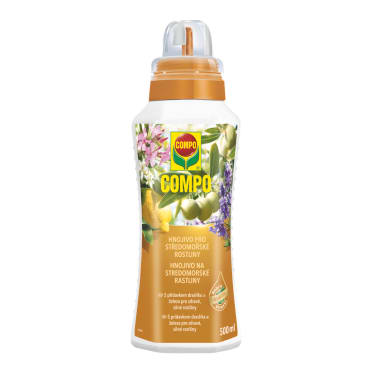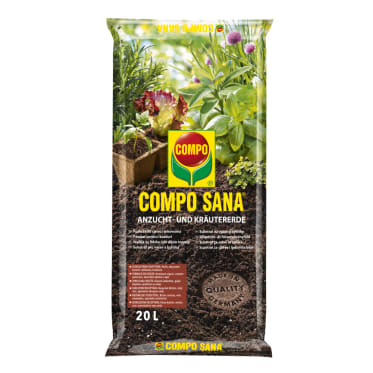Frequent search terms
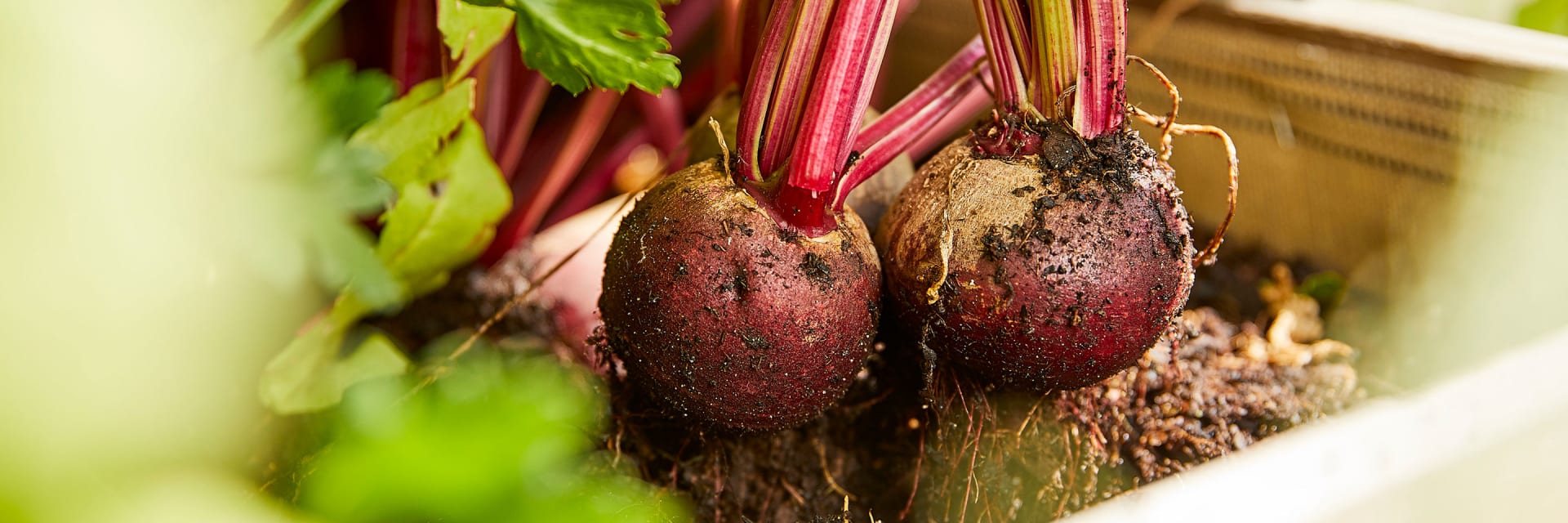
- COMPO
- Guide
- Plant Care
- Herbs, fruits and vegetables
- Growing fruit and vegetables on your balcony
Creating a snack corner
Growing fruit and vegetables on your balcony
Fancy super-sweet strawberries, freshly picked tomatoes or ripe peaches but don't have a garden? No problem! You can also grow a wide range of fruit and vegetables on your balcony. Discover which plants you can easily grow in small spaces and how to create your very own snacking balcony in this article.
Creating the right conditions
Planting tips for the balcony garden
As long as you pay attention to a few things, many fruit and vegetables are easy to grow on your balcony. Of course, on a balcony you can't think on the same scale as you can in a garden. Instead of ten or 20 tomato plants in a greenhouse, you might have to settle for two tomatoes. With that in mind, pay attention to these two things when planting:
- Sufficient space: If you want to grow vegetables or berry bushes on your balcony, the growth habit plays an important role. Depending on how tall or wide they grow, the plants need sufficient space to develop. This applies not only to the visible parts of the plant, i.e. the green shoots and leaves, but also to the root system. This means that you should always pay attention to the information on the label and plant your fruit and vegetables in sufficiently large planters.
In addition, special balcony vegetables that remain extremely compact and low are also available. Instead of a stake tomato of two metres tall, it's better to plant a 30-centimetre bush tomato. For example, three 'Primabell' dwarf tomatoes will fit in a one-metre-long balcony box, while a large stake tomato needs a container of at least 30 centimetres in diameter. The situation for fruit is similar. A broad selection of compact fruit varieties bred especially for growing in a pot is now also available for balcony gardeners with a sweet tooth. - Bright location: Regardless of whether you grow fruit or vegetables on the balcony or in the garden, it's important that the plants get enough sunlight. This is because most species need a certain amount of sun to develop flowers and fruits. While bountiful and varied harvests are possible on a sunny south-facing balcony or on semi-shaded east- or west-facing balconies, fruit and vegetable growing will not yield much on a shaded north-facing balcony.
Before planting, also pay attention to the information on the label. Ideally, a sunny location means the plant will see the sun from morning to evening. A semi-shaded location means the plant should be in the sun for at least half of the day.

Which plants are suitable?
Creating a snack corner – the right plants
Growing fruit and vegetables on your balcony is easier than people often think. A mini raised bed, a few large containers and some hanging baskets or a hanging shelf are all it takes to create quite a lot of space even on smaller balconies. This will allow you to enjoy a bountiful and colourful harvest in the summer. Whether you prefer to nibble on vegetables or sweet berries, we show you which plants you can use to turn your balcony into a little snacking paradise!

1. Multicoloured balcony vegetables
If you're looking to turn your balcony into a snacking corner with delicious sweet vegetables, you'll be spoilt for choice: tomatoes, cucumbers, Swiss chard, spinach, sweet potato, kohlrabi, beetroot – in principle, almost every vegetable plant can be grown on the balcony, as long as you've got enough space.
Vegetable varieties that produce small, bite-sized fruits are especially recommended to nibble on. These include small radishes, mini carrots, small cherry tomatoes or special mini-snack vegetables, for example. Such 'snack' vegetables are the perfect size for eating immediately after you pick them. So, instead of long snake cucumbers, simply plant a few mini-snack cucumber varieties with fruit of only about ten centimetres in length when you pick them.
12 vegetable plants for the balcony
The following vegetable varieties are especially suitable for growing if you're a beginner and want to try your hand:
|
Vegetables |
Tips for the location |
|
Tomatoes |
Sunny; depending on variety, the container's diameter should be at least 30 centimetres – for bush tomatoes a diameter of 15 to 20 centimetres is sufficient |
|
Peppers and chillies |
Sunny; depending on variety, the pot's diameter should be between 20 and 30 centimetres |
|
Radishes |
Sunny to semi-shaded; also easy to sow in a balcony box – do not sow the seeds too densely |
|
Lettuce, e.g. lamb's lettuce, cabbage lettuce, curled lettuce |
Sunny to semi-shaded; lettuce is perfect for planting in boxes or a mini raised bed |
|
Carrots |
Sunny to semi-shaded; perfect for sowing in mini raised beds |
|
Sugar peas |
Sunny to semi-shaded; perfect for pots or mini raised beds |
|
Beans |
Sunny to semi-shaded; depending on variety, ideal for containers or mini raised beds |
|
Garlic |
Sunny to semi-shaded; good for balcony boxes or mini raised beds |
|
Beetroot |
Sunny to semi-shaded; can be grown in deep planters or raised beds |
|
Swiss chard |
Sunny to semi-shaded; depending on variety, good for large containers |
|
Cucumbers |
Sunny to semi-shaded; depending on variety, the container's diameter should be at least 30 centimetres |
|
Eggplants |
Sunny; good for large containers, though there are also special balcony eggplants that are grown in smaller planters |
If you've got a relatively large balcony, you can also try courgettes or pumpkins. For both plants, you should allow about one square metre of space per plant.
By the way, tomatoes or potatoes can also be cultivated in grow bags or directly in the soil bags. Before you plant the vegetables in a bag with soil, you should poke a few holes in the grow bag to allow excess water to drain off.
Tip! Location preferences, growing indoors or directly in a vegetable patch – if you're now at a loss as to how best to cultivate your vegetables, tips for beginners can be found in our article on how to grow vegetables without a green thumb.

2. Sweetness from a bush! Balcony fruit
When it comes to snacking, strawberries are an especially popular balcony plant! Not only do they taste great when freshly picked, they are also incredibly easy to grow in pots, window boxes, mini raised beds or hanging baskets. Plus, compact berry bushes growing just a metre or so tall, like 'Summer Lovers Patio Red' raspberries, let you enjoy sugar-sweet berries straight from the bush.
You can also include small balcony fruit trees like a small balcony peach, which will charm you with its enchanting pink flowers in the spring and delicious peaches in the summer. Although special fruit trees of this nature remain about one metre tall in a pot, they can reach a height of up to two metres in the garden.
For even more Mediterranean holiday flair, small lemon trees, dwarf pomegranates or mini orange trees are perfect. Balcony almond trees, cape gooseberries, figs or papayas are also good for planting in a container.
Classics like apple, cherry, plum or pear can also be grown on a balcony. You can achieve this by planting special columnar fruit trees. Unlike their garden counterparts, a columnar fruit tree grows very slowly and remains quite compact. Thanks to its height of up to 2.5 metres, a columnar pear or cherry tree is also ideal for use as a privacy screen – and provides a magical display of blossoms in the spring! To prevent your columnar fruit trees from tipping over in strong winds, it's advisable to plant them in a heavy pot.
Tip! You should check whether your columnar fruit or your berry bushes need a new pot every two to three years. These perennials should be planted in fresh substrate every four years at the latest.

3. Beauty and spice: Flowering herbs
In addition to fruit trees in a container and balcony vegetables, you can also grow all kinds of herb, of course. From basil across rosemary to chives, if you can still find a few free spots on your balcony, simply plant some herbs! As a rule, herbs remain quite small and compact, meaning they are easy to grow in a pot or flower box. The 'Magic Blue' bush basil attracts a lot of bees for pollination and is a real feast for the eyes. Parsley, rosemary, oregano, curry plant, thyme or chives are wonderful herbs for use in the kitchen as seasoning. And sage, peppermint and chamomile can be used as medicinal herbs for a cold, making them a great addition to the home pharmacy. They are wonderful for making herbal teas.

By the way, in addition to being pretty, some plants that you would think of as 'flowers' at first glance are also wonderful spice herbs. These include the signet marigold or the nasturtium, for example. The colourful flowers of these plants can be used in desserts or heartier dishes. English lavender not only enchants bees and butterflies with its aromatic flowers. Used sparingly, it can also spice up a wide variety of dishes – from cheesecake to fillet.
In addition, similar to roses or eucalyptus, lavender can be used for bath salts, scented candles or body oils. Although this doesn't give you anything to nibble on, it's another great way to make use of this pretty scented plant.

When can we get started?
The right time to plant balcony vegetables and snacking fruit
You can plant many fruit trees or berry bushes in your balcony garden in early spring – but you should always pay attention to the weather. If strong frosts still prevail, it's advisable to leave the plants indoors in front of the window for a little longer.
Particular care should be taken in the case of flowering fruit plants, as the flowers are often susceptible to frost – even if the actual tree is winter hardy. Accordingly, it's advisable to put the fruit tree indoors if it starts to freeze during the flowering period. To make sure you can still look forward to a bountiful harvest, you should take pollination into your own hands and carefully dab the flowers with a brush.
While broad beans, root vegetables such as parsnips or carrots and various leafy vegetables can be sown in the vegetable patch in early spring, other vegetable plants like tomatoes, cucumbers or peppers can only be planted outdoors after the last frost has passed.
Of course, if it's already warm and sunny in April, then you can put the balcony vegetables outdoors earlier. Begin by putting the plants outdoors in warm but cloudy weather. This will allow the plants to gradually get used to their new surroundings. At night, when it gets cooler again or frost is actually forecast, bring the vegetable plants back indoors. If you were to place your pepper plant in the blazing summer heat all of a sudden without warning, this balcony vegetable could suffer sunburn.
Tip! If you want to pre-germinate the frost-sensitive vegetables, you should do so on a bright, warm windowsill.

Mediterranean oasis with raised vegetable beds
How to create a snack corner!
The balcony is spacious and south facing. Due to its sunny location, the balcony is ideal for growing balcony vegetables and sun-loving fruit varieties.
A colourfully planted raised bed with bush basil, nasturtium, bush tomatoes, mini snack peppers, rosemary, tagetes and strawberries growing inside it sets the scene on the balcony. A planting plan for seasonal raised bed plants can be found in our article on planting raised beds.
Two hanging baskets are suspended on the left- and right-hand side of the balcony. Each hanging basket has a diameter of nearly 30 centimetres, providing room for three strawberry plants. The advantage here is that the strawberries can hang over the edge easily without touching the floor. This prevents rot.

A small and cosy sitting area, lights as well as sun-worshiping plants like papaya, lavender and eucalyptus lend a touch of holiday flair. Thyme and rosemary can also be found in one of the balcony boxes. Being Mediterranean herbs, they love the sun, cope well with short dry spells and need very little fertiliser. This makes them wonderfully suitable for cultivation on a south-facing balcony and they can be planted together easily because of their similar needs.
In addition to colourful ornamental plants, the other balcony boxes also contain tagetes, parsley and chives. Parsley is a little diva. Having said that, if balcony gardeners water and fertilise parsley regularly, they will enjoy it for up to two years. You should refrain from eating parsley when it sprouts for flowering in the second year. Instead, many bees will enjoy the herb.

Snacking balcony in the spring
Tip! Plant winter hardy balcony vegetables and strawberries from March
You can start growing vegetables and fruit from as early as March or April if you feel like it. For example, you can sow small radishes and carrots or plant lettuces and strawberries if the weather is good. The delicious balcony vegetables and sweet strawberries can be complemented with winter hardy horned violets. You can also use these pretty-looking colourful flowers to garnish salads and desserts.
When there is no longer a risk of late frosts, from May onwards, you can plant other vegetables like tomatoes or peppers instead of horned violets, lettuces and small radishes.
More on the topic of fruit and vegetable growing
Suitable products for your snacking balcony



